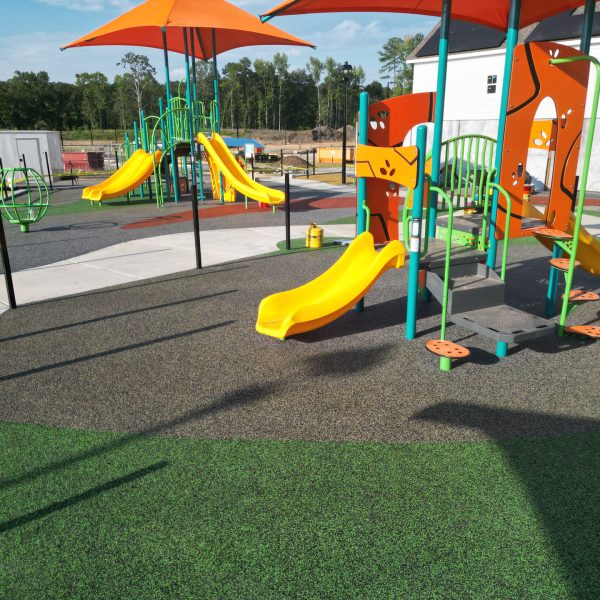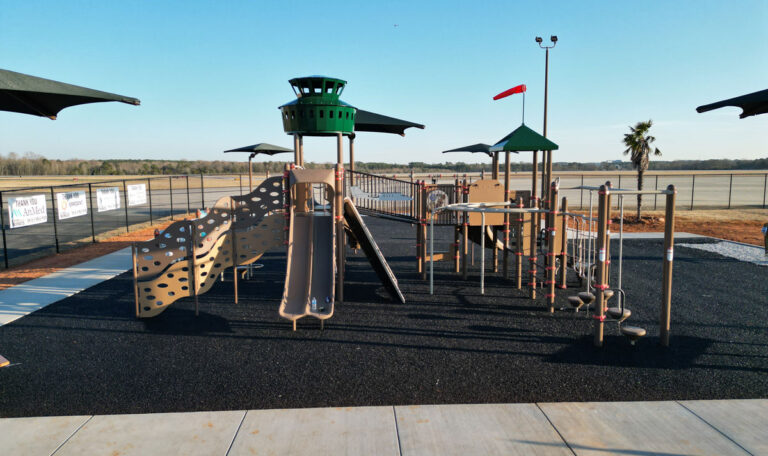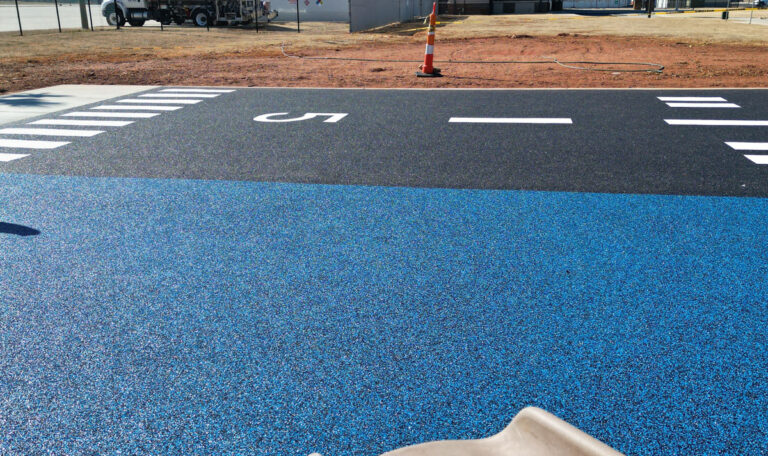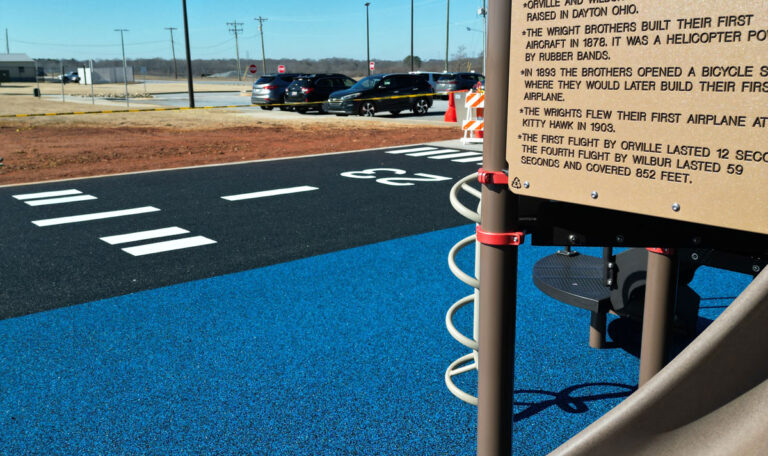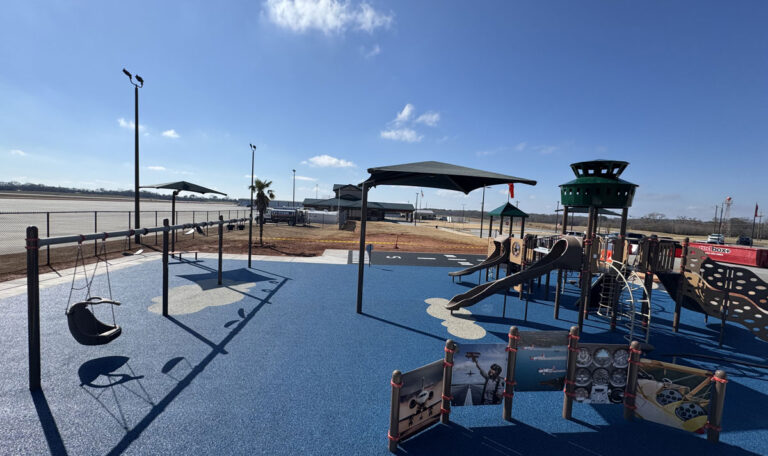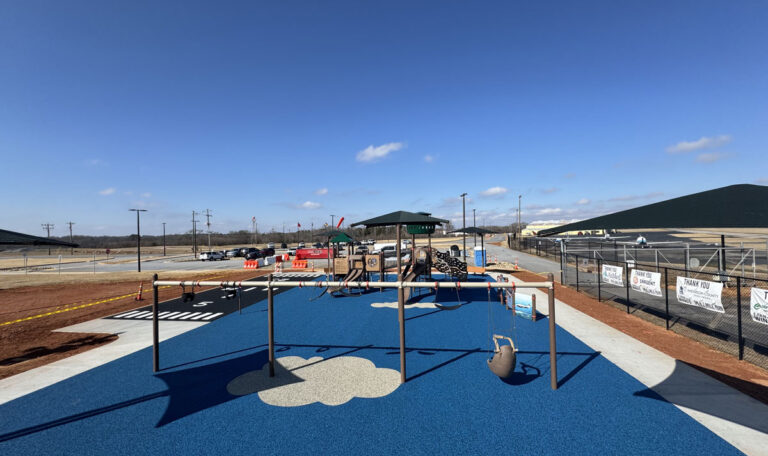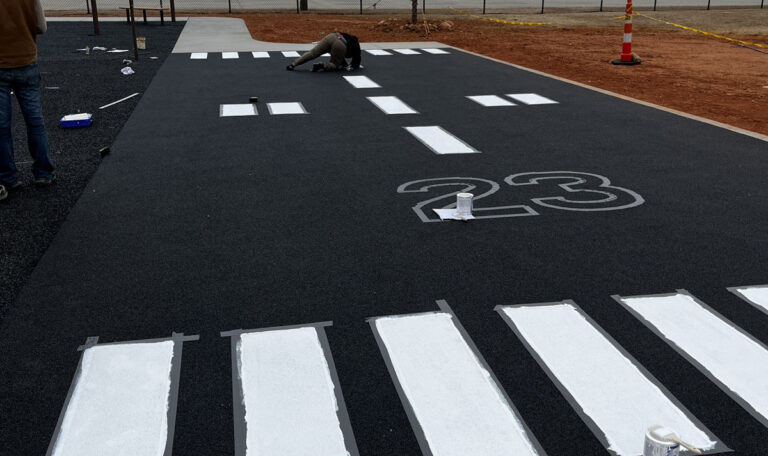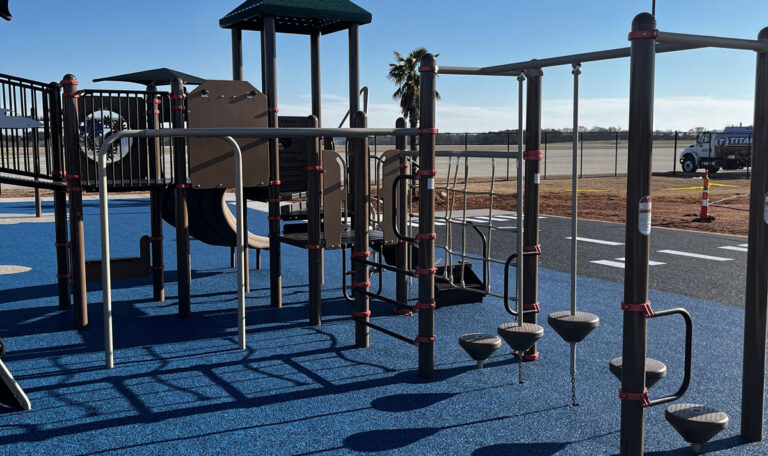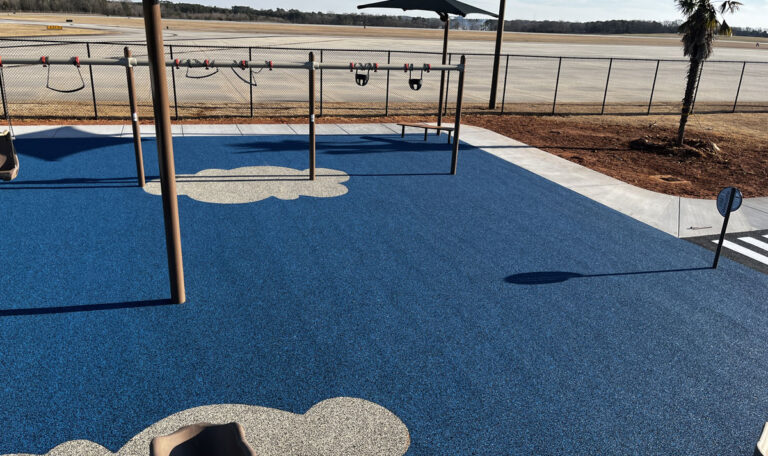Installing rubber mulch is a smart choice for eco-conscious facility managers who want to combine playground safety, durability, and environmental benefits. It’s a simple process that offers a low-maintenance, long-lasting solution for your playground and sports areas. Here’s a quick guide for installing rubber mulch:
- Analyze the site: Consult a certified engineer or landscape architect.
- Prepare the base: Remove debris and plan for drainage.
- Grade the area: Ensure proper drainage with appropriate grading.
- Install landscape fabric: Use quality fabric to prevent weeds.
- Evenly spread the mulch: Use tools like rakes for consistent coverage.
- Consider wear mats: Protect high-use areas under swings and slides.
Rubber mulch promises a safe, durable, and eco-friendly surface. It reduces maintenance hassles and aligns with your sustainability goals.
My name is Landon Olson, and I’ve spent years developing and promoting eco-friendly surfacing solutions, specializing in installing rubber mulch. With my engineering background and deep dive into sustainability, I help facilities choose and install the best rubber mulch solutions for their playgrounds.

Site Preparation
Before installing rubber mulch, it’s crucial to prepare your site properly. This ensures the safety and longevity of your playground surface. Let’s explore the key steps for effective site preparation.
Debris Removal
Start by clearing the area of any debris. This includes removing rocks, stumps, and any existing wood mulch. Why is this important? Debris can affect the safety and evenness of your rubber mulch layer. Wood mulch, in particular, can decompose and cause moisture-related issues underneath your new surface.
Base Preparation
Once the area is clear, focus on preparing the base. A well-prepared base improves drainage and helps keep your mulch in place.
- Landscape Fabric: Lay down a quality landscape fabric to prevent weeds. This fabric also separates the soil from the mulch, reducing the chance of mulch sinking over time. Use a 3oz non-woven spunbond fabric for strength and durability.
- Compacted Sand or Gravel: For commercial playgrounds, consider adding a sub-base of compacted sand or gravel. This isn’t always necessary for residential areas, but it can provide extra stability.
- Drainage System: Ensure proper drainage to prevent water accumulation. Grade the area so water flows away from the playground, avoiding any pooling that could compromise safety.
Grading
Proper grading is essential. It ensures water flows away from the playground, preventing puddles that can be hazardous. Aim for a slight slope, directing water to a drainage system or a natural runoff area.
Retaining Borders
For above-ground rubber mulch installations, retaining borders are a must. They keep the mulch contained and give your playground a polished look. Choose borders that are at least 1 to 2 inches above the mulch to minimize kick-out.
By following these steps, you set the stage for a safe and long-lasting playground surface. Next, we’ll look at the delivery and application of rubber mulch to complete your installation process.
Installing Rubber Mulch
Once your site is ready, it’s time to move on to installing rubber mulch. This involves a few key steps to ensure a smooth and effective process. Let’s explore how to get the job done right.
Rubber Mulch Delivery
Rubber mulch can be delivered in three main ways: smallsacks, supersacks, or in bulk. The choice depends on the size of your playground and your specific needs.
- Smallsacks are ideal for smaller areas or if you want to manage the installation gradually. They are easy to handle and maneuver.
- Supersacks are larger and suitable for medium to large projects. They offer a good balance between convenience and volume.
- Bulk delivery is the most efficient for extensive playgrounds. If space allows, a dump truck can directly unload the mulch into the play area.
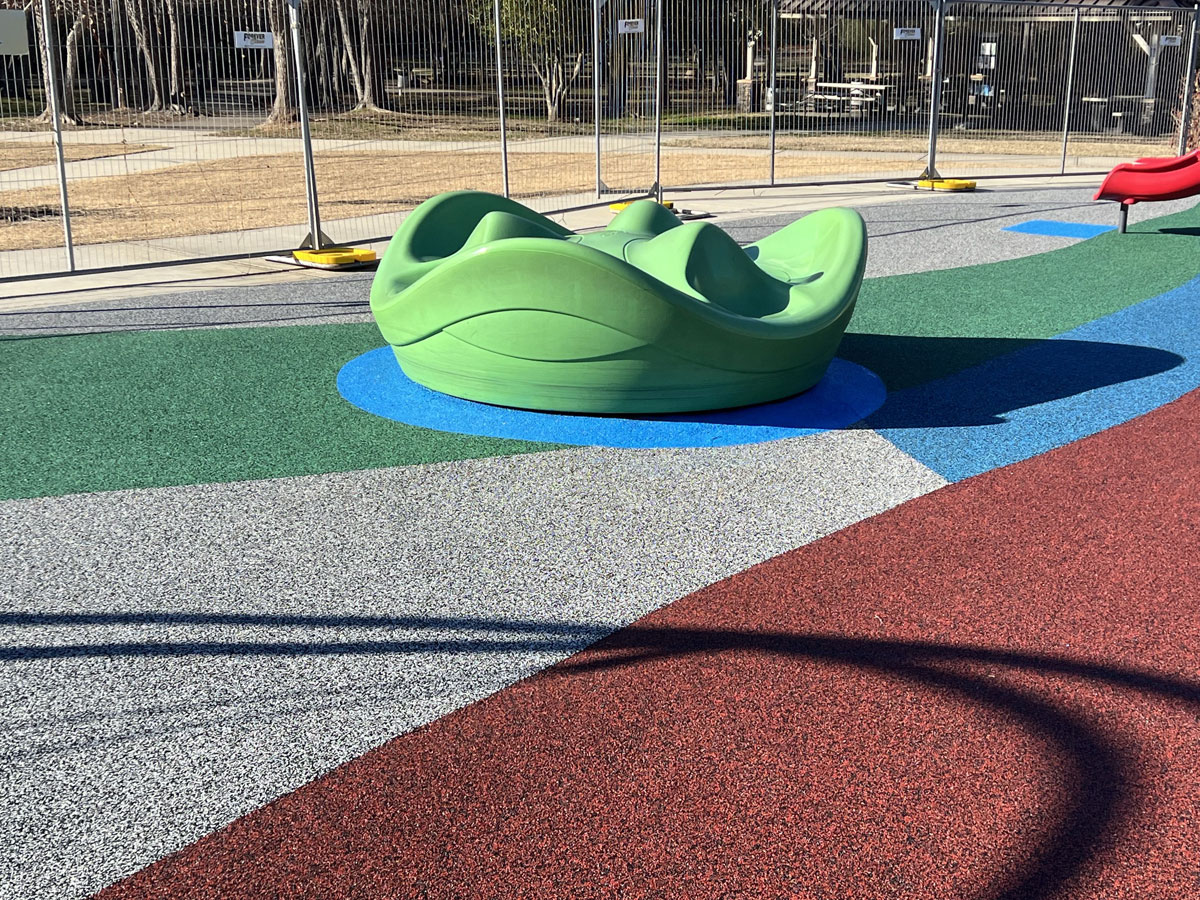
Tools and Application
To apply rubber mulch, you’ll need a few essential tools and materials. Here’s a quick list:
- Rake and Shovel: These are your primary tools for spreading and leveling the mulch. A rake helps to distribute the mulch evenly, while a shovel is handy for moving larger amounts.
- Geo-Textile Fabric: This fabric is crucial for maintaining the integrity of the surface. It prevents the mulch from mixing with the soil below and helps with drainage.
- Hand-Raking: After spreading the mulch, hand-raking ensures a smooth, even surface. It’s a simple step that makes a big difference in the playground’s appearance and safety.
Rubber Wear Mats
In high-traffic areas like beneath swings or slides, rubber wear mats are highly recommended. These mats help maintain a consistent depth of the mulch, minimizing displacement over time. They are easy to install and can be placed directly on top of the mulch. These mats should not be used alone but in conjunction with the mulch to maximize safety.

By carefully planning your delivery and using the right tools, you can ensure a successful rubber mulch installation. This sets the stage for a safe and durable playground surface.
Maintenance and Care
Maintaining your rubber mulch playground is key to keeping it safe and looking great. Here, we’ll cover how to benchmark and care for your playground surface effectively.
Benchmarking
Benchmarking involves setting standards to ensure your playground remains safe and visually appealing. Start by marking the depth of the mulch. This helps you monitor any areas where the mulch might be thinning out. High-traffic zones, like under swings and slides, often require more attention. Use a simple stick or a depth marker to check these areas regularly.
Another aspect of benchmarking is identifying high traffic areas. These spots can experience more wear and tear, leading to uneven surfaces. Consider adding extra mulch or using rubber wear mats in these areas to maintain a consistent depth.
Aesthetic Care
Keeping your playground looking fresh is easier than you think. Regular aesthetic care includes simple tasks like periodic raking. Raking helps redistribute the mulch, ensuring an even surface and mixing the top layer with deeper mulch to refresh its color.
For debris removal, a rake or leaf blower can be your best friend. These tools efficiently clear away leaves, sticks, and other unwanted materials that may accumulate over time. Regular cleaning not only keeps the playground neat but also extends the life of your mulch.
By following these maintenance tips, you ensure that your playground remains a safe and inviting place for children to play. Next, we’ll answer some frequently asked questions about installing rubber mulch to further improve your understanding and confidence in maintaining a top-notch playground surface.
Frequently Asked Questions about Installing Rubber Mulch
Do you need to put anything under rubber mulch?
Yes, it’s highly recommended to install landscape fabric under rubber mulch. This fabric acts as a barrier to prevent weeds from growing up through the mulch. Although it doesn’t stop 100% of weeds, it significantly reduces their growth, making maintenance easier. Plus, it helps water drain efficiently, which is crucial since rubber mulch doesn’t absorb water.
How to prepare the ground for rubber mulch?
Proper ground preparation is essential for a successful rubber mulch installation. Start with grading the area to ensure it slopes slightly away from structures for water drainage. Next, ensure a compacted surface by adding a layer of compacted sand or gravel. This provides a stable base and further aids drainage.
Consider installing a drainage system if the area is prone to water pooling. This could involve using drainage pipes or channels under the mulch to direct excess water away.
How do you keep rubber mulch in place?
To keep rubber mulch where it belongs, use retaining borders. These can be made of wood, plastic, or metal and act as a barrier to prevent the mulch from spreading beyond the play area.
For high-traffic zones, like under swings or at the base of slides, consider adding rubber wear mats. These mats reduce mulch displacement and provide extra cushioning, enhancing safety.
By using these methods, you can ensure your rubber mulch stays put, providing a safe and tidy playground surface.
Learn why non-toxic rubber mulch is the safest choice for playgrounds in our detailed guide
Conclusion
At Replay Surfacing Inc., we’re passionate about changing environmental hazards into sustainable playground solutions. By recycling tires into durable rubber surfacing, we reduce waste and provide a safe play area for children. Our mission is to turn potential environmental threats into opportunities for safer and more eco-friendly playgrounds.
Rubber mulch is a groundbreaking product that offers a host of benefits. It provides excellent impact absorption, slip resistance, and long-term durability, making it ideal for playgrounds. Plus, it’s an eco-friendly choice, as it repurposes materials that would otherwise contribute to landfill waste.
Installing rubber mulch is a straightforward process, and with the right preparation, it can last for years with minimal maintenance. It’s a smart investment for any playground, offering long-term savings and improved safety.
By choosing Replay Surfacing Inc., you’re not only opting for high-quality materials but also contributing to a sustainable future. We’re dedicated to providing top-notch products that are both safe and environmentally responsible.
For more information on our playground solutions, explore our playgrounds service page. Join us in making playgrounds safer and our planet greener.

